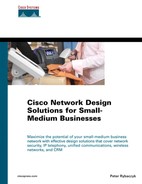Summary
This chapter explored the data networking infrastructure and addressed design considerations relating to its key elements. Those elements include telecommunications closets and their most common components (cabling, switches, and routers), network servers and storage solutions, power protection, and the user desktop environment (including workstations and other network peripherals). Cabling, switching, and routing encompass the bottom three layers of the OSI model and are accompanied by numerous standards and choices in equipment and protocols, offering you the opportunity to accommodate a wide range of SMB infrastructure requirements.
Network servers and storage solutions were discussed in the context of their interface to the network, topology, and impact on the network bandwidth. The user desktop environment, which includes workstations and other network peripherals, was addressed in a similar context. The “Power Protection” section considered the available tools and the process of calculating the requirements. Network upgrade planning was then discussed, with an emphasis on making it part of any effective network design process from the start. This chapter concluded with a discussion of the impact of applications, choices in e-mail systems, and approaches to network management.
